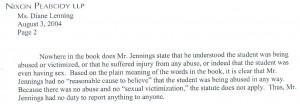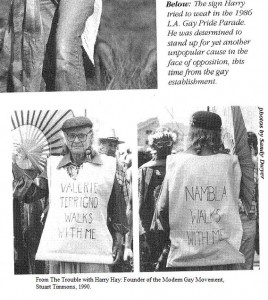As noted here two days ago, Kevin Jennings made a statement regarding a student’s disclosure of involvement with an older man while Jennings was a teacher at Concord Academy. Here again is the statement:
Twenty one years later I can see how I should have handled this situation differently. I should have asked for more information and consulted legal or medical authorities. Teachers back then had little training or guidance about this kind of thing. All teachers should have a basic level of preparedness. I would like to see the Office of Safe and Drug Free Schools play a bigger role in helping to prepare teachers.
Since then, left-leaning websites, some gay advocates (although a notable exception is Gaypatriot who says Jennings should resign) and CNN have commented further on the matter, defending Jennings. At issue is dispute over Brewster/Robertson/Thompson’s age – was he 15 or 16? And does it matter?
Media Matters, parroted by CNN, asserted that Brewster was 16, not 15. If Brewster was 16, Jennings was not required to report sexual conduct because 16 was the age of consent in MA. Their reasoning is:
Massachusetts law required reporting by those with reason to believe child “is suffering serious physical or emotional injury resulting from abuse.” According to a footnote in a 1990 Massachusetts Supreme Judicial Court case, in 1988, chapter 119, section 51A, of the General Laws of Massachusetts provided:
[Any] public or private school teacher … who, in his professional capacity shall have reasonable cause to believe that a child under the age of eighteen years is suffering serious physical or emotional injury resulting from abuse inflicted upon him including sexual abuse … shall immediately report such condition to the department by oral communication and by making a written report within forty-eight hours after such oral communication …
Jennings’ attorney: Book passage does not indicate that Jennings had reason to believe student was being abused. In the letter, Boland stated, “Nowhere in the book does Mr. Jennings state that he understood the student was being abused of victimized, or that he suffered injury from any abuse.” Boland added, “Based on the plain meaning of the words in the book, it is clear that Mr. Jennings had no ‘reasonable cause to believe’ that the student was being abused in any way. Because there was no abuse and no ‘sexual victimization,’ the statute does not apply.” [Boland letter, 8/3/04]
Media Matters accuses Politico’s Mike Allen and Fox News of not reporting all of the facts in this instance. While they may be correct about some omissions, they also make omissions in their reporting. For instance, Media Matters does not include all of what Boland said on behalf of Jennings.

They left out the phrase, “…or indeed that the student was even having sex.” In light of Jennings’ 2006 book where he was advising Robertson on safe sex, the description from his book, One Teacher in Ten, where Brewster disclosed a relationship with an “older man” in Boston, and the 2000 speech where Brewster went home with someone he met in a Boston bathroom, this statement from Boland now seems misleading. Media Matters also ignored the audio of the 2000 speech where Jennings himself said that the boy was 15 years old. He also said that Brewster was an advisee and that he learned about the Boston trip early in his first year. Here is what he said about it:
And in my second job I wasn’t sure how I wanted to deal with that. And I was in my first month on the job and I had an advisee named Brewster. Brewster was missing a lot of classes; he was in the boarding school so I said to his teacher, his first period teacher, I said, ‘next time Brewster misses a class I want you to tell me that he’s missed that class and, uh, I will go find him.’ So I went and found Brewster one morning when she had called and he was asleep in his dorm room. And I said, “Brewster, what are you doing in there asleep?” And he said, “Well, I’m tired.” And I said, “Well we all are tired and we all got to school today.” And he said, “Well I was out late last night.” And I said, “What were you doing out late on a school night.” And he said, “Well, I was in Boston…” Boston was about 45 minutes from Concord. So I said, “What were you doing in Boston on a school night Brewster?” He got very quiet, and he finally looked at me and said, “Well I met someone in the bus station bathroom and I went home with him.” High school sophomore, 15 years old. That was the only way he knew how to meet gay people. I was a closeted gay teacher, 24 years old, didn’t know what to say. Knew I should say something quickly so I finally said, My best friend had just died of AIDS the week before. I looked at Brewster and said, “You know, I hope you knew to use a condom.” He said to me something I will never forget, He said “Why should I, my life isn’t worth saving anyway.”
Why did they omit those details? Surely, they are relevant to the defense they are trying to mount.
I don’t know how old Brewster was or even if there is a Brewster. Only Mr. Jennings know this and up to now, he has not disclosed much. I can understand some of this. It is not uncommon for speakers to disguise details of case studies in order to preserve confidentiality. Age might be one of those details. Readers will have to judge which account seems more plausible.
The credibility of statements in the Boland letter is now open to review given the 2000 speech, the 2006 book and the statement from Mr. Jennings this week. I am puzzled that Media Matters (then followed by CNN and others) would rely so heavily on it and ignore other relevant information.
The other age-related wrinkle here is the requirement that mandated reporters (teachers in public and private schools are mandated reporters) notify the Department of Social Service if they have
reasonable cause to believe…that a child under the age of eighteen years is suffering physical or emotional injury resulting from abuse inflicted upon him which causes harm or substantial risk of harm to the child’s health or welfare including sexual abuse…
Everybody seems to stipulate that if the boy was 15 then a report should have been made. However, if not, then what? One would need to make a judgement call about the nature of the disclosures and whether they are causing the child under 18 to experience injury. Given the repeated statements that the boy was suicidal, something was not right and needed some attention. What was causing the boy’s distress?
We may be dealing with an issue of attribution. Apparently Jennings believed the boy’s suicidal thoughts were coming from a lack of acceptance of his sexual attractions. Many gay defenders of Jennings point to this as quite likely and have an intuition to relate to his 1987/1988 response. However, others may believe the suicidal thoughts derive from his youthful sexual behavior and possible remorse or dissonance. Some might wonder if he was struggling with his sexual identity. Still others might suggest mental illness or some combination of all three. Different attributions about the cause of the behavior will lead to different actions on the part of the teacher. It is difficult enough for people who are trained in mental health to make these calls, it surely is above the pay grade of an inexperience teacher to be certain. The law says that suspicion of abuse is needed not certainty. With that in mind, Jennings admission that he should have sought consultation is a step in the right direction.
There is a larger issue here which I will take up in future post. When ideological differences are great, how can we develop policies and procedures which help offset our biases? Brewster is like a Rorschach test for projecting adult recollections of adolecent angst. Each of us look at the situation and think, ‘he needed this or he needed that.’ As many have opined through the years when reflecting on GLSEN, perhaps what adolecents need is not to be turned into a political movement but guided in light of their individual needs.
UPDATE: Media Matters apparently is the PR arm of the Department of Education and has released what they say is a photo of Brewster’s license. MM however, continues to avoid dealing with what Jennings said to his own constituents about the boy’s age.
UPDATE #2: A Brewster has come forward to express support for Jennings. CNN has the summary and Media Matters has the details, including a Facebook conversation between FOX News reporter, Maxim Lott and Brewster. The account provided by this Brewster is confusing when trying to reconcile it with Jennings’ past accounts and the recent statement that he should have handled the situation differently. While Media Matters has focused on the exact age of the boy, the group has not addressed the discrepancies in past accounts. They accuse FOX of wildly inaccurate reporting but fail to note that the reporting was based on Jennings own statements.
f the school day to bring attention to anti-gay bullying. This year has been much quieter than the first two years for the supportive Golden Rule Pledge. I am aware of students in a dozen or so communities who planned to pass out GRP cards, either while joining in the silence or indenpendently of it.


